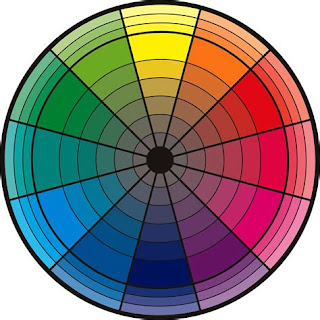Hearing Colors
In my study I have two color wheels. Not being a visual artist such as a painter, I've had to learn about color theory on my own. The color wheels are fascinating to me, as they show various properties such as complementary colors, split complementaries, triadics, tetrads, analogous colors, and more. This includes concepts such as tint (color plus white), and shade (color plus black).
There are multiple music connections here for me. One is intervalic pitch-class theory. Intervallic pitch-class theory states that there are complementary intervals within a pitch-class; for example, seconds and sevenths. I'd also add ninths to that pitch-class. Intervallic pitch-classes are a fine and proven method for tonal organization. I use them extensively, though it's always been intuitive. I don't have to stop and think about intervalic pitch-classes when composing a piece; it comes pretty naturally.
You could think of intervallic pitch-classes as being a kind of aural equivalent to the color wheel.
Recently I tried some experimentation with mixed intervallic pitch-classes. It was mildly surprising to me that I'd not previously considered this, but to be honest, it happened without my knowing it at the time. It was only after the fact did I realize that this new piece was based on mixed intervallic pitch-classes. I had blended thirds and sixths with seconds, sevenths, and ninths. It's not supposed to work, but it's not the first compositional or musical theoretical rule that I've broken or damaged. It worked perfectly for what I was attempting, which was a harmonic environment that was rather jagged and harsh. I don't hear it as harsh; for me it is a harmonic texture, a fabric that I'm attempting to realize. But I suspect others might hear it as harsh and that's understandable. To return to the color wheel for a moment, this would be like choosing two or three entirely unrelated colors and painting a picture using only those unrelated colors.
I use some unusual tunings of my own creation on my guitar-family instruments. One of my long-term collaborators who has become one of my closest friends had a discussion with me on day while we were on tour. He said I shouldn't be using such dark intervals in the bass register; he felt it clashed too much. That's understandable and not an invalid observation. I explained to him why I used those darker and denser intervals in bass registers. For me, it's like the color black. Look at any painting, and then imagine all the black is removed. Here's one example: Vermeer's Das Glas Wein anagoria from 1658.
-kk






Comments
Post a Comment